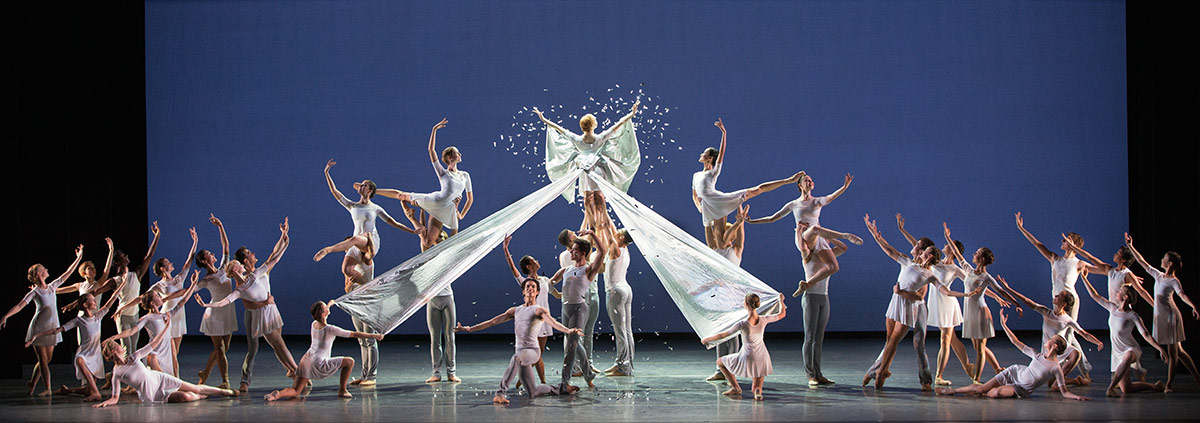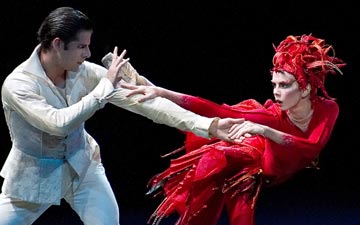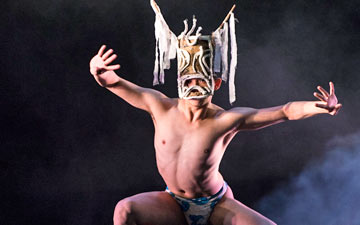
© Marty Sohl. (Click image for larger version)
American Ballet Theatre
Fall Gala: The Gift, Songs of Bukovina, Thirteen Diversions
★★★✰✰
New York, David H. Koch Theater
18 October (mat) 2017
www.abt.org
davidhkochtheater.com
Opening Salvo
One often hears about the ABT miracle – the company’s ability to pull things together just in time for the season – but the truth is that many of its opening nights have a rough-edged quality. This is especially true when the company is premiering a new work by Alexei Ratmansky, a choreographer known for making changes up until the very last moment. This year’s fall gala, which included the unveiling of Ratmansky’s new Songs of Bukovina, was no different.
The event doubled as a salute to its artistic director of twenty-five years, Kevin McKenzie. A quarter century is indeed a significant milestone, especially in these times of rapid change. His tenure has had many successes: financial stability first of all, but also the snagging of an important choreographer and a new emphasis on advancing talent from within the company. He deserves the accolades.
There were the usual speeches, with much emphasis on diversity and inclusion. An award was given to Valentino Carlotti, a member of the board who is also Misty Copeland’s sponsor and a major supporter of the company’s “Project Plié,” a program that offers ballet classes to kids all over the country in collaboration with the organization Boys & Girls Clubs of America. Ms. Copeland introduced Mr. Carlotti with genuine warmth.
In between the speeches and the short films came the dancing. The main attraction was the new Ratmansky work, Songs of Bukovina, set to a recently-completed suite of piano preludes by the Ukrainian-Russian composer Leonid Desyatnikov. They were played by the Russian pianist Alexey Goribol, to whom Desyatnikov dedicated them. (The ballet contains only half of Desyatnikov’s twenty-four preludes; the full set will premiere in Perm, Russia next May.) Ratmansky has made six ballets to Desyatnikov’s music, more than with the music of any composer besides Shostakovich. In a recent interview, the two discussed their musical and esthetic affinities and shared backgrounds: both grew up in Ukraine and both have Jewish backgrounds, though neither is religious. Both are postmodernists with a curiosity about Soviet themes; both are drawn to strong rhythms, folk melodies, stylistic games.*
Songs of Bukovina has a strong folk feel, unsurprising given that Desyatnikov’s preludes are based on folk songs from the region of Bukovina, an area that lies in the Carpathian mountains, partly in Ukraine and partly in Romania. Ratmansky’s dances are rhythmic, often sharp, frequently mournful. There is a note of danger, particularly in a solo for the male lead (Calvin Royal III) in which he darts here and there, like a soldier making his way home from the front line. Four men creep around, like a search party. He’s both heroic and terrified. For some reason, I was reminded of the Death figure in Kurt Jooss’s The Green Table.

© Marty Sohl. (Click image for larger version)
The lead couple was danced by Christine Shevchenko and Calvin Royal. But they didn’t dominate the ballet; much of it was given to the ensemble of four men and four women. The dancers appear as a group, as couples, and also as individuals. The tone shifts dramatically from section to section. At one point, the men grab the women roughly, but the women shake them off. At another, the ensemble becomes almost ceremonial. The dancers advance in slow, very beautiful, waves. Joo Won Ahn dances a striking solo near the beginning in which he seems to soar like a bird, arms flapping upward, feet curving behind him like a tail – an image that will return. Later, at a moment when the music sounds like a Schubert lied, Ahn is partnered by three women, who hold him in a curved, sculptural arabesque, face turned upward as if awaiting a blessing.
Shevchenko and Royal drift in and out of the ensemble; their relationship to each other and to the others is unclear. Their duet is fast, sharp, full of backward-moving hops set to drone-like music. Shevchenko’s solo begins quietly and then builds to a circle of staccato jumps in which her legs twist and bend in the air, as if she were dancing on hot coals.
What’s not really clear at this point is how it all hangs together. One gets the distinct impression that the choreography hasn’t yet settled. On opening night, the steps had a kind of undercooked look. Goribol’s playing was full of color and warmth; each piece had a distinct character and texture. But the communication between Goribol and the dancers was spotty. The music and the dance seemed to exist on different planes. And so the ballet felt fuzzy, out of focus. This impression was compounded by flat, un-dramatic lighting (by Brad Fields) and shapeless costumes (by Moritz Junge). As with most of Ratmansky’s pieces, I suspect things will become clear as the dust settles. I’ll report back.

© Marty Sohl. (Click image for larger version)
The evening opened with The Gift, an efficient showcase for kids from the company school and studio company, by Jessica Lang. Her ballet Her Notes is also part of the repertory this season. The score, which begins with recordings of the kids describing what they feel when they dance – “I feel a sense of adrenaline and happiness,” says one – then segues into excerpts from various Corelli concerti grossi. What follows is a pot-pourri of classroom steps, as these sorts of things usually are: turning, jumping, partnering, and running. Lots of running. All of it well put-together if somewhat generic, including the music. The one big flourish is a giant silver lamé costume for one of the young women that billows when she is carried across the stage, a theatrical flourish that is repeated several times to diminishing effect.
The closer was Thirteen Diversions, made for the company by Christopher Wheeldon in 2011. The ballet looks as handsome as ever, though the ensemble here too appeared somewhat under-rehearsed. The music, by Benjamin Britten (“Diversions for Piano (left hand) and Orchestra”) is grand and atmospheric, the choreography elegant and formal. Wheeldon gives the audience exactly what it wants: crisp pointework, clean and graceful port de bras, flattering costumes inspired by formal-wear. And a pas de deux in which the female dancer (Misty Copeland) is folded and unfolded in lift after lift, upside down, right side up, every which way. The male partner, Gray Davis, is essentially a hydraulic lift. It’s a ballet that aims to please, as smooth as silk and as insubstantial as a whiff of expensive perfume.
* Full disclosure: I’m in the process of working on a book about Ratmansky.

















I love this extraordinary review! The writing is so specific and concrete that I’m left with images in my mind of these dancers whose work, to say nothing of these particular examples, I have never seen.
I am also captivated by the reference to ABT’s Serenade after Plato’s Symposium. My mind staggers when I ask it to visualize dance based on Plato’s Symposium, a work as far from ballet as my mind can imagine.
I was transfixed by this review of a performance I did not see and the very concrete description of the dancing. The specificity of the description communicates images to the reader that stay in the mind as if their origin were visual.